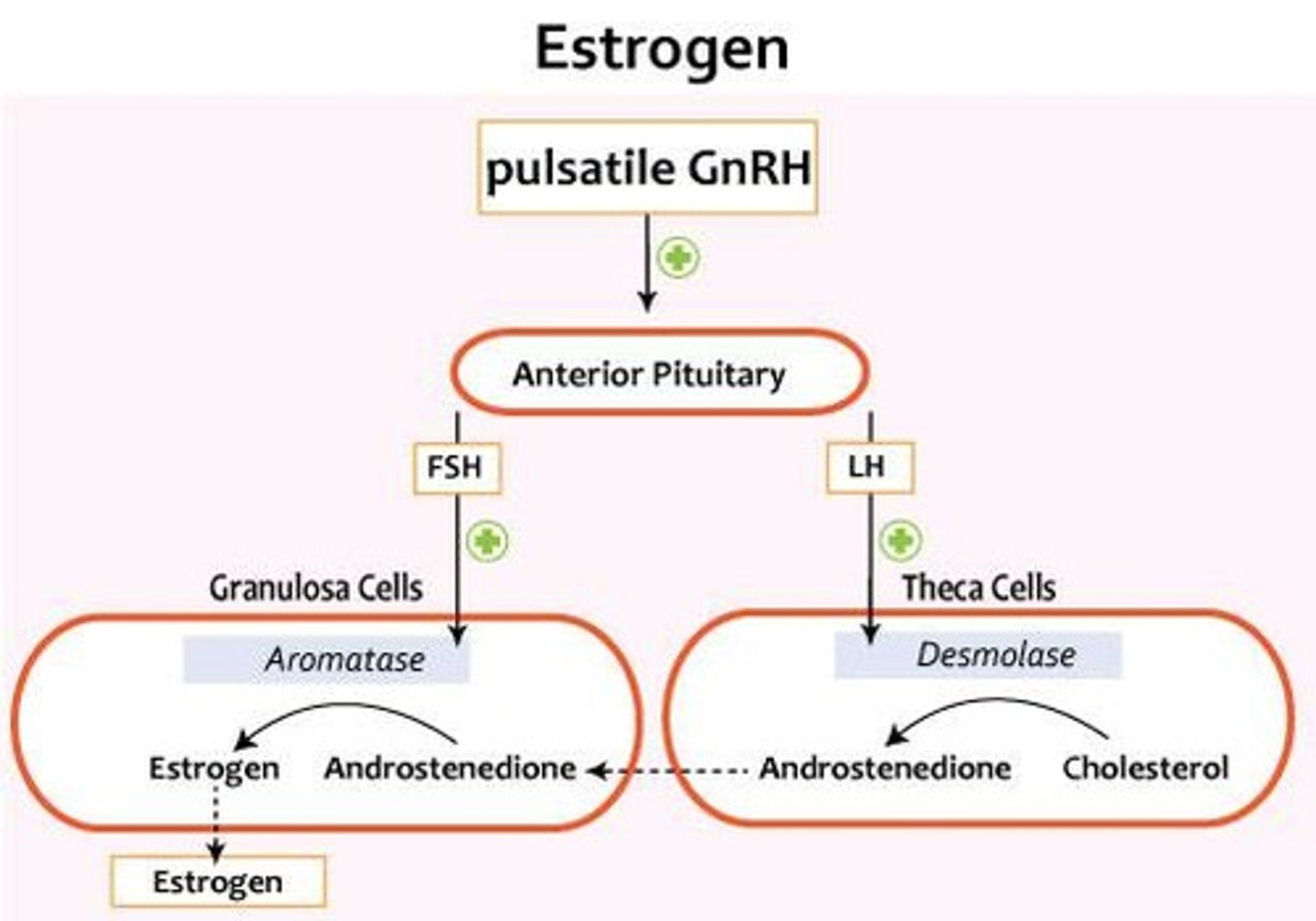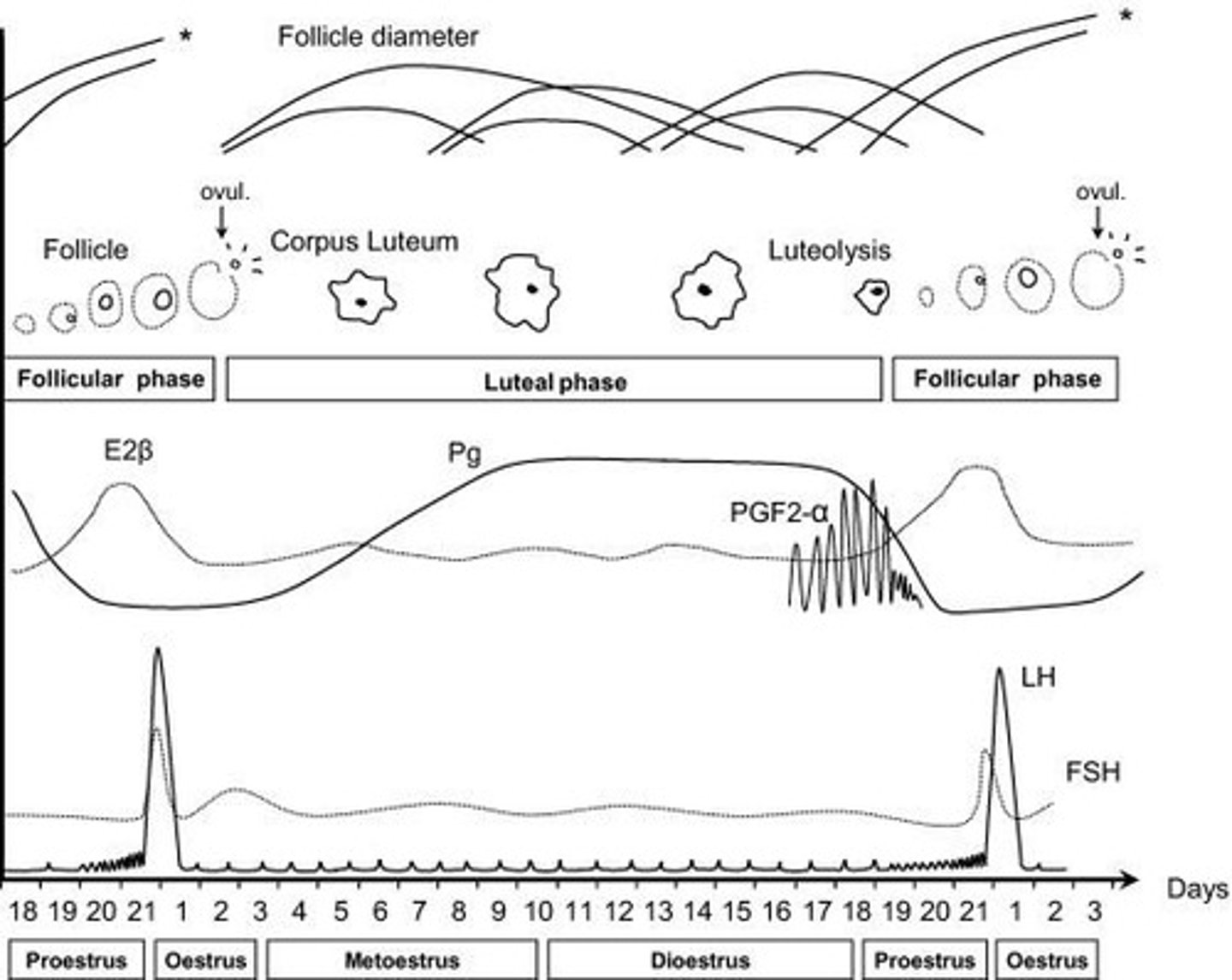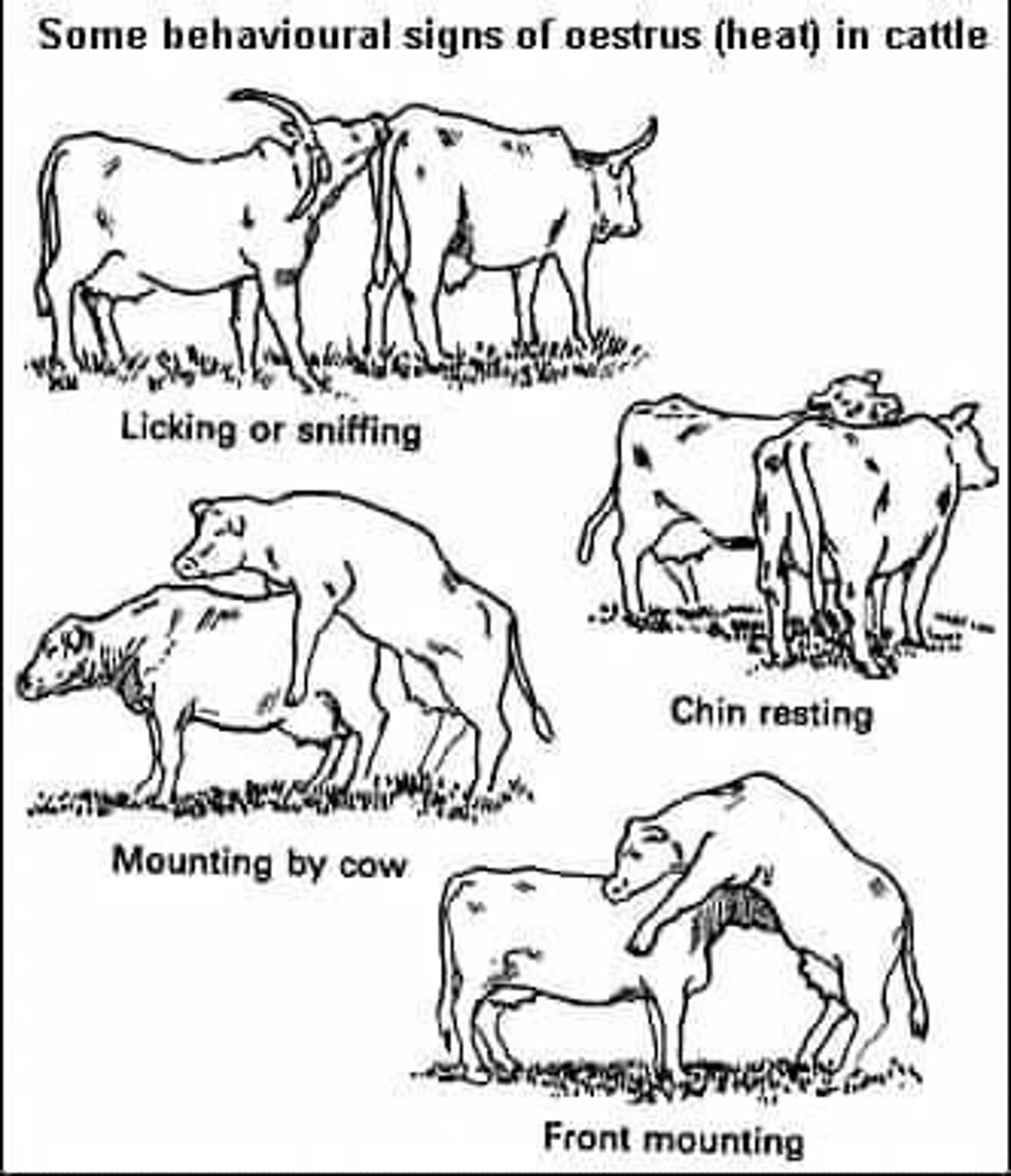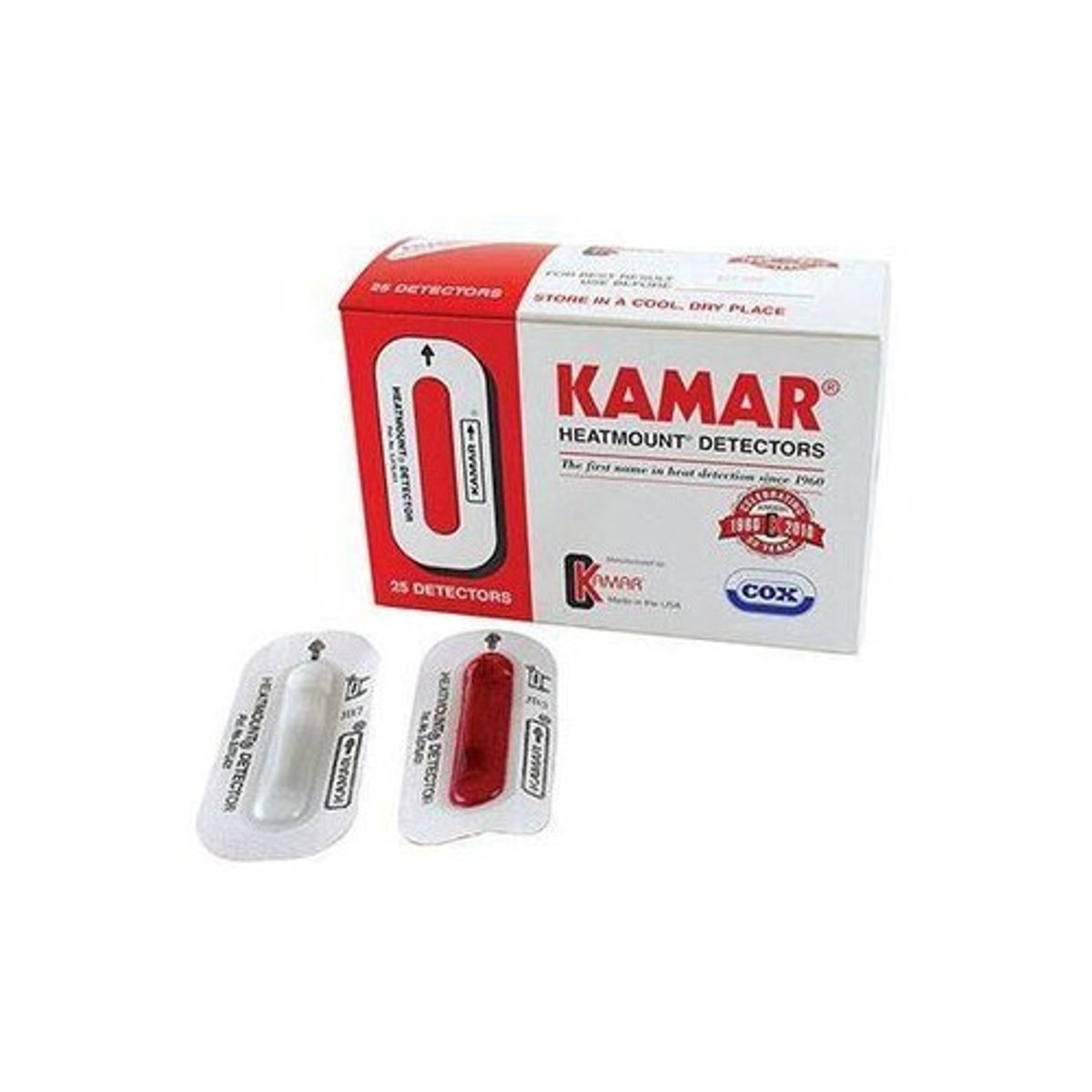Livestock Breeding Cycles
1/59
There's no tags or description
Looks like no tags are added yet.
Name | Mastery | Learn | Test | Matching | Spaced |
|---|
No study sessions yet.
60 Terms
GnRH
Gonadotrophin releasing hormone.
FSH
Follicle stimulating hormone.
LH
Luteinising hormone.
ABP
Androgen-binding protein.
Follicular Phase
GnRH secreted from hypothalamus in a pulsatile manner stimulates release of follicle stimulating hormone (FSH) and pulsatile luteinising hormone (LH).

Follicular Phase
FSH binds to FSH-R on granulosa cells of follicle, increasing follicular growth and development.
Follicular Phase
LH binds to LH-R on theca cells stimulating androstenedione synthesis.
Follicular Phase
Androstenedione diffuses to granulosa cells and is converted to oestrogen (oestradiol 17b) under the influence of FSH.
Follicular Phase
Growing (dominant follicle) secretes inhibin, providing negative feedback at pituitary to inhibit release of FSH.

Follicular Phase
Oestradiol stimulates GnRH and LH secretion (positive feedback loop).
Follicular Phase
Oestradiol levels surge peaking on day 0 of cycle and causing oestrus behaviour.
Ovulation
Rising oestradiol concentrations increase LH pulse frequency, with 1 pulse every 75 min at start of follicular phase and 1 pulse every 45 min on day 0 of oestrous cycle.
Ovulation
Oestradiol peak causes a surge in LH concentrations (the LH surge) lasting approx. 12 h, inducing ovulation.
Ovulation
Granulosa and theca cells luteinise to form the large and small cells of the corpus luteum respectively.
Luteal Phase
LH binds to LH-R on small cells of corpus luteum stimulating the synthesis of progesterone.
Luteal Phase
Progesterone acts at hypothalamic-pituitary axis to suppress LH pulse frequency though LH pulse amplitude increases.
Luteal Phase
Low frequency, high amplitude LH stimulates further progesterone secretion.
Luteal Phase
Large luteal cells synthesise progesterone in absence of an LH stimulus, and progesterone concentration steadily increases to a max on day 8-10 of cycle.
Luteal Phase
Progesterone binds to progesterone receptors in uterine endometrium and myometrium, preparing the uterine environment for pregnancy.
Luteal Phase
Progesterone leads to proliferation of endometrium, increased secretory activity, and increased endometrial vasculature.
Luteolysis
Progesterone remains high until regression of the corpus luteum.
Oestrus/Estrus
The noun for the period of sexual receptivity in female livestock.

Oestrous/Estrous
The adjective describing the period of sexual receptivity in female livestock.
Polyoestrous
Numerous breeding cycles per year without a specified season.
Year round calving
Calving occurs throughout the entire year.
Sexual maturity in Bovine
Reached at 9-12 months of age or 60% of mature body weight.
First calf aim
Aim to have the first calf at 24 months of age.
Breeding age for Bovine
Bred at 14 to 15 months of age.
Calving interval
Calving interval of 365 days.
Oestrus detection in Bovine
Involves observing behavioral cues, physical cues, and changes in activity.
Behavioural cues for Oestrus
Includes standing to be mounted, chin rubbing, chin resting, flehmen, licking, and lordosis.
Physical cues for Oestrus
Swollen vulva and clear, elastic vaginal mucus.
Oestrus detection methods in Bovine
Methods include observing behavioral cues, using teaser bulls, and detection aids.
Teaser bulls reliability
2 x per day: 80-90% reliability.
Heat mount detectors
Detection aids with 40-80% reliability.

Activity monitors
Pedometers measure steps with 80-90% reliability.
Mating in Bovine
Mate when oestrus first detected, with specific conditions for heifers and cows.
Conception rate at first service
Average 40% for Bovine.
Seasonal polyoestrous
Numerous breeding cycles during a specific time of year.
Oestrus detection in Ovine
Limited behavioral cues and some physical cues such as swollen vulva.
Oestrus synchronisation in Ovine
6-8% of ewes in oestrus each day of the breeding season.
Ram:Ewe ratio
Ideal ratio is 1 ram to 10 ewes.
Advantages of Progestogen treatment
Relatively cheap, quickest method of synchronisation in sheep.
Disadvantages of Progestogen treatment
Environmental contamination with residual progesterone and antibiotics.
Advantages of Prostaglandin treatment
Rapidly metabolised in the lung, clean, green, and ethical.
Disadvantages of Simple Application
Pregnancy rates lower than progesterone-treated or untreated ewes. Can't synchronise ewes out of breeding season. Can be more costly than sponges.
Mating: Ovine
Usually natural mating with synchronised oestrus. Introduce ram 48h after sponge removal. No return to oestrus indicates pregnancy (scan to confirm). Cover flock with rams 2 weeks after first mating for any infertile ewes. Use of artificial insemination is limited in commercial flocks. Pedigree flocks use artificial insemination and embryo transfer.
The Breeding Cycle: Porcine
Polyoestrous. Year-round breeding with continuous litters (intensive systems). Sexually active from 7 months of age. Usually first bred at 210 days old. Aim for 2.5 litters per year. Pregnant 3 months, 3 weeks 3 days. Wean piglets at 21-28 days lactation. Inseminate 4-8 days after weaning.
Oestrus Detection: Porcine
Long and variable oestrus period of 36-96 hours. Physical signs include reddening and swelling of vulva (48h prior to oestrus). Behavioural signs include Standing Reflex, Restlessness, Urinating more frequently, Cocking position of ears.
Oestrus Synchronisation: Porcine
Altrenogest: progestin (a synthetic progestogen) mimics progesterone, delays oestrus. Oral administration for 18 consecutive days. Withdrawn on day of weaning (in sows). In oestrus within 5 days.
Oestrus Synchronisation: Sows
Not required for sows. Will come into oestrus 4-8 days post-weaning (typically 5-6 days).
Effect of Season on Breeding: Bovine
Not seasonal breeders (no anoestrus) but seasonal effects. Higher conception rate 90d post-calving in autumn-calving cows. Conception rate higher when inseminated at temperatures between 7 and 15 degC.
Heat Stress in Dairy Cows
Physiological effects include decreased dominance of selected follicle, decreased oestradiol concentrations, altered progesterone concentrations, decreased oocyte and embryo quality, increased failed embryo implantation, and negative energy balance increases calving-conception interval.

Effect of Season on Breeding: Ovine
Seasonal (short-day) breeders. GnRH regulates LH and FSH; secretion of pituitary hormones is also regulated by photoperiod (day length). Melatonin synthesis is suppressed by light; during short days melatonin synthesis increases.
Ram Effects on Breeding
Reduced libido, reduced sperm quality, reduced sperm quantity, altered protein profile of seminal plasma.
Ewe Effects on Breeding
Anoestrus (non-cyclic).
Out of Season Breeding
Use sponges/CIDRs and pregnant mares serum gonadotrophin (PMSG) to induce ovulation. Use semen collected and stored during the breeding season.
Summary of Breeding Cycles
Breeding cycles in females are regulated by hypothalamic, pituitary and ovarian hormones. Livestock species vary in their reproductive physiology. A thorough understanding of the breeding cycle is required to optimise productivity.

Techniques in Livestock Breeding
Techniques such as oestrous synchronisation can aid livestock breeding programmes.
Reproductive Function Influences
Reproductive function is affected by season (sheep) and climate (cattle).